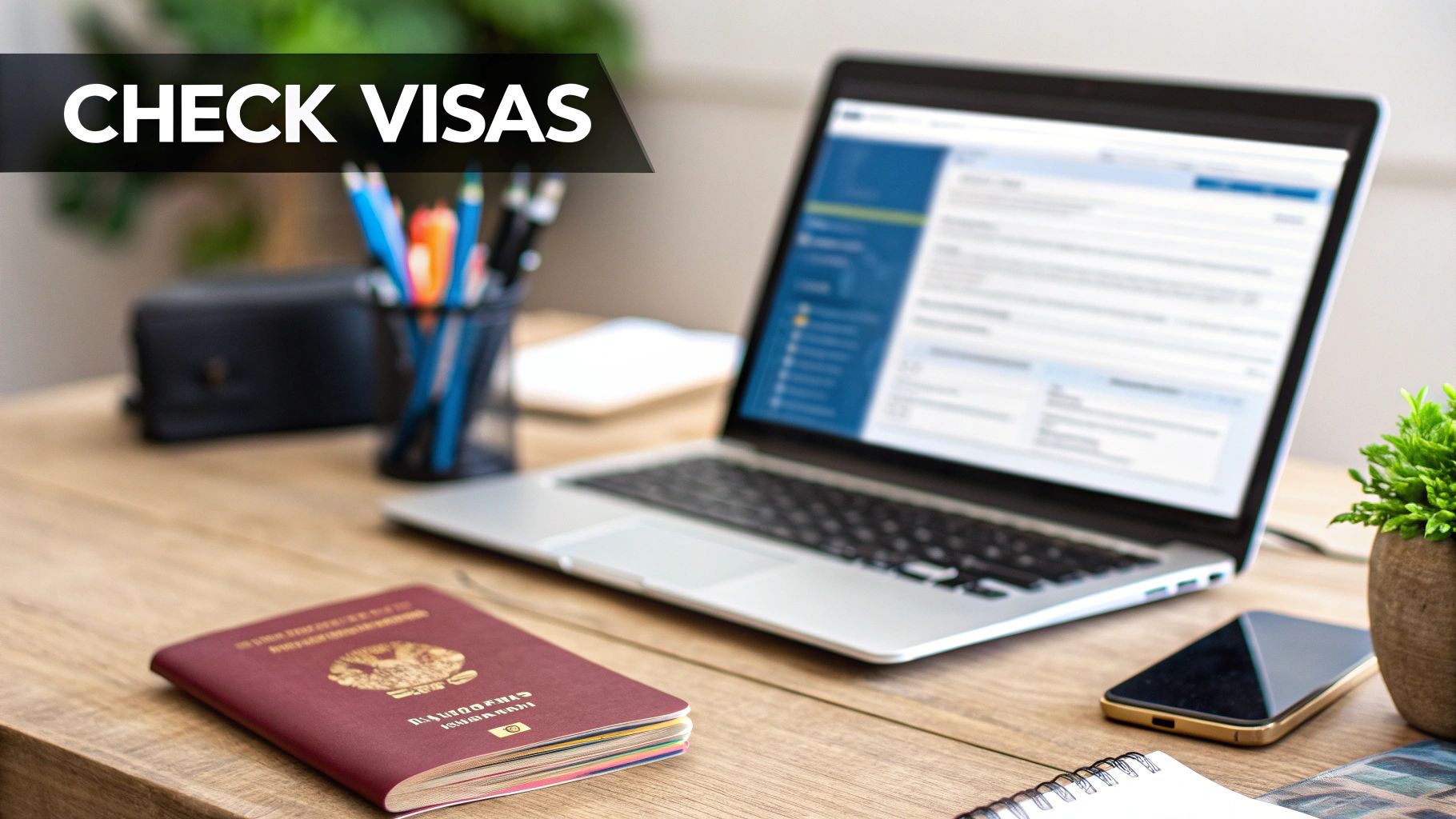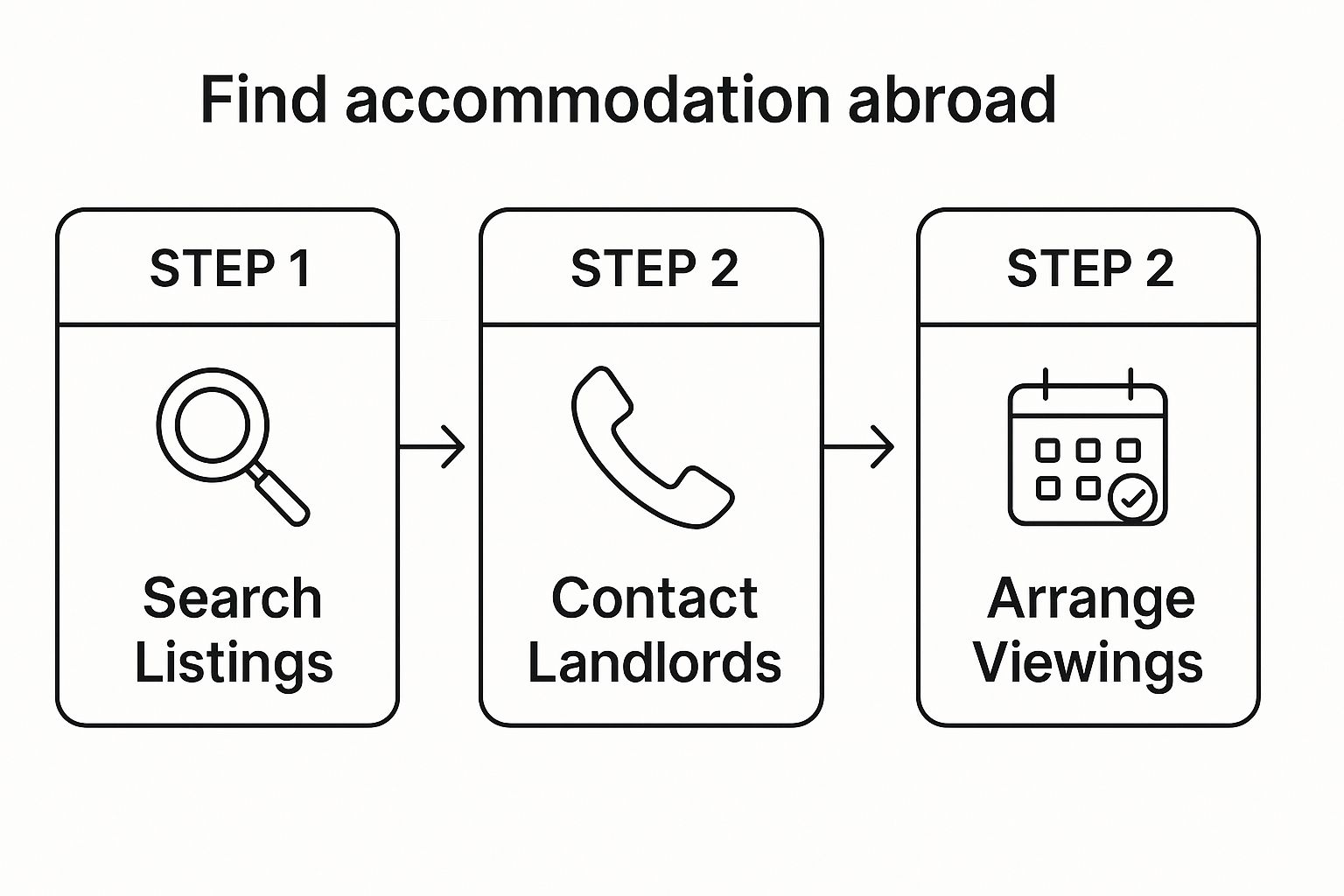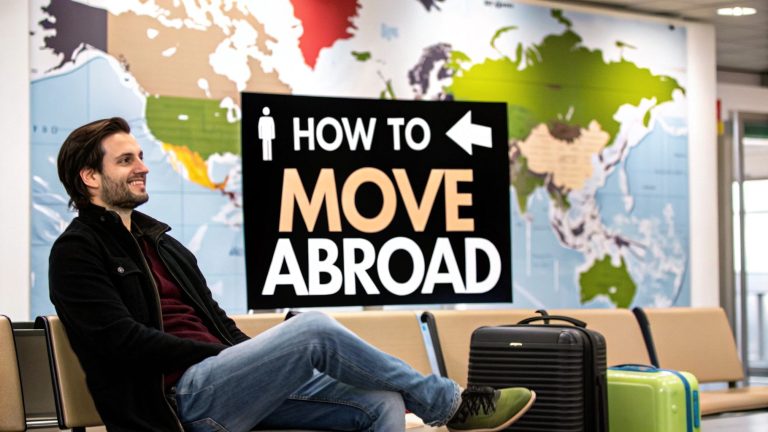Moving abroad is a life-altering decision, but it’s one that absolutely depends on clear goals, deep research, and a realistic timeline. The journey doesn’t start with packing boxes. It starts with some serious soul-searching to figure out your ‘why,’ nail down the right country, and then chop the whole adventure into bite-sized, manageable pieces.
Building Your Foundation for an International Move

Before you even glance at flight prices, the real work happens right at your desk. This foundational stage is all about building a rock-solid plan that will steer every single decision you make from here on out. A successful move is built on honest self-awareness and gritty research, not just a passing desire for adventure.
This is where you turn a vague dream into a concrete, actionable strategy. It’s about making sure your chosen destination actually lines up with your career, your lifestyle, and your bank account.
Clarify Your Personal ‘Why’
First things first: you need to understand your core motivation for moving abroad. This ‘why’ is going to be your anchor when things get tough—and trust me, they will. Are you chasing professional growth, a slower pace of life, a full cultural immersion, or just want to be closer to family?
Whatever your reasons are, write them down or you can use our relocation tool to help you to decide. Seeing them on paper turns them from hazy ideas into solid objectives. This clarity is everything because it will directly shape which countries even make your shortlist.
Let’s get practical: A software developer might be laser-focused on moving to a tech hub like Berlin to climb the career ladder and get access to the EU market. On the other hand, a retiree might have their sights set on countries with a warm climate, affordable healthcare, and a laid-back vibe, like Portugal or Costa Rica. Your ‘why’ sets your priorities straight.
Choosing the Right Country
It’s so easy to get swept away by postcard images, but you have to look beyond them. Your ideal country must fit your practical, everyday needs. This means doing a serious deep dive into the factors that will define your daily life and, ultimately, your happiness. A great way to do this is by creating a ‘country scorecard’ to compare your top contenders objectively.
A classic mistake is falling in love with a vacation spot without ever thinking about the day-to-day grind of living and working there. A two-week holiday in Rome is a world away from navigating its bureaucracy and job market.
Your scorecard should weigh a few key areas:
- Career Opportunities: Does the country have a strong job market for what you do? What are the average salaries, and how do they stack up against the cost of living? Practical Example: A nurse researching a move to Australia would look at the demand for nurses in specific states like Victoria or Queensland, check salary bands on sites like Seek.com.au, and compare that to rent prices in Melbourne vs. Brisbane.
- Visa Realities: Let’s be real—how hard is it to get a work or residency visa? Some countries have clear-cut paths for skilled workers, while others are notoriously difficult. Researching this early can save you from major heartbreak down the road.
- Cost of Living: Don’t just look at rent. Dig into the costs of groceries, public transit, utilities, and healthcare. A fat salary in an expensive city might leave you with less cash at the end of the month than a moderate one in an affordable town. Practical Example: Use a tool like Numbeo to directly compare the cost of a liter of milk, a monthly metro pass, and an internet bill between your home city and potential destinations like Toronto and Vancouver.
- Lifestyle and Culture: Are you a bustling city person or a quiet-town soul? What are the social norms, and do they resonate with your personality?
Creating a Realistic Timeline
The whole process of moving abroad can feel completely overwhelming. The secret is to break it down into smaller, achievable goals and plot them on a realistic timeline. A typical timeline, from the “I’m doing this” moment to landing in your new home, can take anywhere from 6 to 18 months. It all depends on things like visa processing times and your own personal situation.
Having a structured timeline keeps the last-minute panic at bay and ensures you stay on track.
Sample Timeline Milestones:
- 12-18 Months Out: Define your ‘why’ and create a shortlist of potential countries. Start your deep research into visa requirements.
- 9-12 Months Out: Lock in your target country. Start saving aggressively for your moving fund. Dust off that resume and update your professional profiles.
- 6-9 Months Out: Kick off the visa application process. This is the time to gather all your essential documents, like birth certificates and university transcripts.
- 3-6 Months Out: If you have your visa, it’s time to start the job hunt in earnest. Begin the great decluttering of your home.
- 1-3 Months Out: Book your flights. Figure out shipping or storage for your belongings. Start notifying banks and canceling local subscriptions.
This step-by-step approach turns the massive task of moving abroad into a series of smaller, more manageable steps. It makes the whole journey feel a lot more controlled and way less stressful.
Frequently Asked Questions
How much money should I save before moving abroad?
A good rule of thumb is to have at least 3-6 months’ worth of living expenses for your target city saved up after you’ve paid for all the initial moving costs like flights, visa fees, and shipping. For a city like Lisbon, this could be $8,000-$15,000, while for London, you’d be looking at $15,000-$25,000 or even more.
Should I find a job before I move?
Ideally, yes. Landing a job before you move gives you financial security and often makes the visa process much smoother, since many work visas require a job offer. That said, in some industries or countries, it’s more common to find a job after you’ve arrived. You’ll need to assess the risk and look at your financial cushion before making that call.
What is the biggest mistake people make in the planning phase?
The biggest mistake, hands down, is underestimating how long visa processing takes and how complicated it can be. Always assume it will take longer than the official estimate and start the paperwork as early as you possibly can. Another common blunder is not creating a detailed budget, which can lead to a world of financial stress right after you arrive.
Navigating Visas and Legal Requirements
Let’s be honest: tackling visas and legal paperwork often feels like the most daunting part of moving abroad. It’s a bureaucratic maze, no doubt about it. But with the right info and a solid game plan, it’s completely manageable. The trick is to realize every country has specific pathways designed for different people, whether you’re a skilled professional or a remote worker.
First thing’s first: figure out which visa category actually fits your situation. Don’t spin your wheels looking at tourist visas if your goal is to live and work there long-term. Your energy is better spent zeroing in on the main types of long-stay permits.
Common Visa Pathways to Explore
Most countries offer a few distinct routes for foreigners who want to put down roots. While the official names and requirements can vary wildly, they generally fall into a handful of key categories. Knowing these will help you pinpoint the right application process from the get-go.
- Skilled Worker Visas: These are built for professionals who have a job offer from a local company. In many cases, the employer sponsors the application, which can seriously simplify the process on your end.
- Digital Nomad or Remote Work Visas: This is a newer, but growing, category. A ton of countries now offer visas for people who work remotely for companies based outside the country. You’ll typically need to show proof of a stable and sufficient income.
- Family Sponsorship Visas: If your spouse, partner, or sometimes another close relative is a citizen or legal resident, they might be able to sponsor your move. This is a very common and direct route.
- Investor or Entrepreneur Visas: Got plans to start a business or make a significant investment in the local economy? These visas offer a direct path to residency for a price.
The path you take dictates everything—the documents you need, how long you’ll wait, and just how complex the whole application will be. For a closer look at what employers are looking for, you can check out our visual guide on visa sponsorship opportunities.
Understanding the Application Process
Let’s look at a couple of real-world scenarios to see just how different these paths can be.
Imagine a software developer aiming for a German Blue Card (a type of skilled worker visa). Their entire application will hinge on a confirmed job offer with a salary that meets a specific government threshold. The most important documents will be their employment contract and university degrees.
Now, picture a freelance writer applying for Portugal’s D7 visa, which is popular with remote workers and retirees. They don’t need a job offer at all. Instead, they have to prove they have a consistent passive income—from things like investments or royalties—that meets Portugal’s minimum. Their application will be all about bank statements and proof of those income streams.
Key Takeaway: There’s no such thing as the “best” visa. The right visa is the one that lines up perfectly with your job, your finances, and what you want to achieve in your new country.
This infographic breaks down another crucial piece of the puzzle: finding a place to live. For many visa applications, having a local address is a non-negotiable prerequisite.

As you can see, you have to be proactive to lock down housing, which is often a key step before you can even finalize your visa.
No matter which visa you apply for, there’s a core set of documents you’ll almost certainly need. Start gathering these as early as you can, because some can take weeks or even months to get. We’re talking about an original birth certificate, certified academic transcripts, a valid passport (with at least a year left on it), and a police clearance certificate from your home country.
Keep in mind that global migration trends can also shape the legal landscape you’re walking into. For example, recent policy shifts have led to a stabilization of migration flows into Europe. While global displacement numbers went up, forced migration arrivals in Europe actually dropped by 40% compared to the previous year. This is a direct result of stricter border management and regional agreements, and it shows how quickly the political climate can change how easy—or hard—it is to move. You can dig into more 2025 migration trends on icmpd.org.
Frequently Asked Questions
What is the most common reason for a visa application to be rejected?
Hands down, the top reasons are incomplete applications and a failure to meet the financial requirements. Triple-check every single form for missing signatures or information. Always provide official, easy-to-read proof of funds that meets or, even better, exceeds the stated minimum.
Do I need a lawyer to apply for a visa?
For a straightforward case, like a skilled worker visa with a solid job offer, you probably don’t need a lawyer. But for anything more complex—like an investor visa, an appeal after a rejection, or a tricky family situation—consulting an immigration lawyer who specializes in your target country is a very wise investment.
How far in advance should I apply for my visa?
Start the process as soon as humanly possible. Check the official embassy or consulate website for their current processing times and then add a few extra months to that as a buffer. A good rule of thumb is to kick off the application process 6-9 months before you plan to fly out.
Managing Your Finances for Life Abroad

Let’s talk money. A successful move abroad is built on a rock-solid financial foundation. Getting your finances in order before you go isn’t just a good idea—it’s absolutely essential for a low-stress transition. This means looking way beyond the price of a plane ticket and getting brutally honest with your numbers.
Your financial game plan needs to cover everything from the huge initial expenses to the tiny daily costs of your new life. Properly planning means you’re ready for every possible financial twist and turn, so you land on your feet, not on your face.
Building Your Relocation Budget
First things first: you need a comprehensive relocation budget. This document is your financial roadmap, mapping out all the one-time costs of the move itself and the recurring expenses for your first few months. So many people underestimate these initial setup costs, leading to a world of pain right when they arrive.
Think of it in two main buckets: one-time costs and initial living expenses.
- One-time costs are the big hitters: visa application fees, your international flight, shipping your stuff, and any travel insurance you need.
- Initial living expenses are your survival fund. Plan for at least the first three months. This buffer should cover rent, a security deposit (which can easily be 2-3 months’ rent), utilities, groceries, and local transportation. Having this cushion means you won’t be scrambling for cash while you’re still trying to find the nearest grocery store.
To give you a clearer picture, here’s a sample budget outlining the typical costs you might encounter when moving to a mid-cost European city.
Sample Relocation Budget Breakdown
| Expense Category | Estimated Cost (USD) | Notes |
|---|---|---|
| One-Time Costs | ||
| Visa Application Fees | $200 – $1,500 | Varies widely by country and visa type. |
| International Flights | $800 – $2,000 | One-way, including extra baggage fees. |
| Shipping Belongings | $500 – $4,000 | Depends on volume (air vs. sea freight). |
| Travel Insurance | $150 – $400 | For the initial transit period. |
| Initial Living Expenses (First 3 Months) | ||
| Rent & Security Deposit | $3,600 – $6,000 | Based on $1,200/mo rent + 2-month deposit. |
| Utilities & Internet Setup | $200 – $500 | Includes connection fees and initial bills. |
| Groceries & Household Items | $1,200 – $1,800 | Stocking up your pantry and buying essentials. |
| Local Transportation | $300 – $600 | Monthly transit passes or ride-sharing costs. |
| Contingency Fund (15%) | $1,012 – $2,445 | Your “just in case” emergency buffer. |
| Total Estimated Budget | $7,962 – $19,245 | A realistic starting point for your savings goal. |
Remember, this is just an example. Your actual costs will depend heavily on your destination and lifestyle choices, so use this as a template to build your own personalized budget.
The cost of moving varies wildly depending on your destination. A move to Bangkok is going to have a completely different price tag than a move to London.
- Moving to Bangkok, Thailand: A security deposit for a one-bedroom apartment might be around $1,000. Add in flights, visa fees, and a three-month living fund, and you could probably budget $7,000 – $10,000 for a comfortable start.
- Moving to London, UK: That same setup could be massively more expensive. A security deposit could easily top $3,000, and with much higher daily living costs, a safe starting fund would be closer to $15,000 – $20,000.
My best piece of advice? Always, always add a contingency fund of at least 15-20% to your total budget. Unexpected costs—from needing new appliances to a sudden dip in the currency exchange rate—are practically guaranteed. This buffer is your financial safety net.
Banking and Money Transfers
Once you have your budget, you need a plan for actually accessing and moving your money. Managing finances across borders can be a nightmare of high fees and terrible exchange rates if you don’t use the right tools.
Opening a local bank account in your new country should be one of your first priorities. It makes paying bills, getting paid, and avoiding insane international transaction fees so much simpler. Do your homework before you go; some banks might let you start the process online, while others require you to show up in person with proof of address.
For moving your savings over, please don’t use a traditional bank wire transfer. They often hit you with awful exchange rates and sneaky fees. Modern fintech services are a total game-changer here.
- Wise (formerly TransferWise): Known for its transparent fees and using the real mid-market exchange rate. It’s fantastic for sending large sums of money without getting ripped off.
- Revolut: Offers a multi-currency account, making it easy to hold and spend money in different currencies with minimal fees. It’s a lifesaver for daily spending right after you arrive.
Seriously, comparing these services can save you hundreds, if not thousands, of dollars on the move.
Understanding Your Tax Obligations
Taxes are an unavoidable part of life, and moving internationally just adds another layer of complexity. The biggest fear for most expats is double taxation—getting taxed on the same income by both your home country and your new country.
Thankfully, most countries have tax treaties designed to prevent this very thing. These agreements spell out which country gets the primary right to tax your income. It’s critical to understand the basics of the treaty between your home country and your destination. A great way to prepare for the financial realities of working abroad is to conduct a detailed skills assessment for your target job market, which can give you a better idea of your earning potential and resulting tax bracket.
You’ll almost certainly need to file taxes in both countries, at least for the first year. Spending a little money on advice from a tax professional who specializes in expat finances is a very wise investment. They can make sure you stay compliant and help you take advantage of any tax credits or exemptions you’re entitled to.
Frequently Asked Questions
How can I prove my income for a visa if I’m a freelancer?
Get organized. Gather at least 6-12 months of bank statements that show consistent income. You’ll also want to include client contracts, invoices, and a formal letter from an accountant verifying your earnings. Many digital nomad visas have specific online portals where you can upload all these documents.
Should I tell my home bank that I am moving abroad?
Absolutely, 100%. If you don’t, they’re likely to see your first international transaction, flag it as fraud, and freeze your accounts. That’s a headache you do not need. Call them, tell them your plans, and ask about their policies and fees for international card use.
Is it better to exchange currency before I leave or when I arrive?
Don’t exchange large amounts of cash at airport kiosks—they have the worst rates, hands down. A much smarter strategy is to use a service like Wise to transfer the bulk of your funds to your new international account. Then, just withdraw a small amount of local currency from an ATM when you land to cover immediate needs like a taxi or a coffee.
Finding a Job and a Place to Live
Once you’ve got the big-picture legal and financial stuff in motion, it’s time to tackle two of the biggest hurdles: finding a job and locking down a place to live. These two goals are tangled together. Landlords often want to see a job contract, while employers sometimes want a local address. It’s a classic chicken-and-egg problem, and the key is to approach it strategically.
So, what comes first? Securing a job before you move offers incredible peace of mind and is often a hard requirement for your work visa. On the flip side, job hunting after you land lets you network face-to-face and get a real feel for the city before you commit. There’s no single right answer here—it all comes down to your industry, how much cash you have saved up, and your personal tolerance for risk.
Mastering the International Job Hunt
Searching for a job abroad is so much more than just translating your resume. It’s a total cultural and strategic pivot. Recruiters in different countries have different expectations, and your application needs to show you get it.
For example, that punchy one-page resume that works wonders in the US? It might fall flat in Germany, where a Lebenslauf is often a more comprehensive document, sometimes including a professional headshot and spanning multiple pages. Taking the time to adapt your resume to local norms proves you’ve done your homework.
Beyond the resume, your online presence is your biggest asset. LinkedIn isn’t just a place to park your work history; it’s your #1 networking machine.
- Build Your Network Proactively: Don’t wait until you’re desperate for a job. Start connecting with recruiters and professionals in your target city months before you even think about moving. A simple, genuine message can open doors. Try something like, “Hi [Name], I’m a [Your Profession] planning a move to [City] and I’m really impressed by the work you’re doing at [Company]. I’d love to connect and learn more about the industry there.”
- Engage with Local Content: Follow companies you’d love to work for and leave thoughtful comments on their posts. This is a low-effort way to get on their radar and show you’re genuinely interested.
- Optimize Your Profile: Pack your profile with keywords relevant to your field and make it crystal clear in your headline that you’re looking for roles in a specific country (e.g., “Software Engineer Seeking Roles in Berlin”).
These proactive moves are essential. You’re stepping into a massive global talent pool—the world is home to roughly 304 million international migrants, making up about 3.7% of the global population. This number has nearly doubled since 1990, which tells you just how competitive the international job market has become. You can dig into more global migration statistics on blog.savvynomad.io.
Navigating Foreign Rental Markets
Trying to find a place to live from thousands of miles away can feel overwhelming, but it’s completely possible with the right game plan. Your first move should be to find the go-to local property websites. Sure, international sites exist, but the local portals are where you’ll find the freshest listings. For example, you’d be on ImmoScout24 in Germany, Rightmove in the UK, or SUUMO in Japan.
Be ready for some culture shock, because the process can be wildly different from what you’re used to. Finding a flat in Berlin often means showing up to a group viewing with dozens of other hopefuls and handing over a full application packet on the spot. In Tokyo, you might have to pay “key money”—a non-refundable gift to the landlord—and find a Japanese-speaking guarantor.
Crucial Tip: Never, ever send a security deposit or sign a lease for a property you haven’t seen, either with your own eyes or through a live video tour with someone you trust. Rental scams are depressingly common, and any landlord who refuses a live walkthrough is a giant red flag.
Understanding how to land a job is a huge piece of the puzzle. You can get more practical tips from our guide on how to find jobs abroad as a foreigner, which often goes hand-in-hand with finding a place to live.

Frequently Asked Questions
How do I handle an international job interview?
Do your research on the company culture. A tech startup in Amsterdam is going to have a much more casual vibe than a bank in Zurich. Be ready to answer questions about why you want to move to that specific country and how you plan to adapt. And always, always double-check the time zone and confirm it in writing.
What documents do I need to rent an apartment abroad?
It varies a lot, but you should have these ready to go:
- Proof of identity (passport and visa)
- An employment contract or other proof of income
- Bank statements from the last few months
- A reference letter from a previous landlord
Should I use a rental agent?
In super competitive markets like Dublin or Paris, a rental agent can be a lifesaver. They get access to listings before they hit the public sites and can help you slice through the local red tape. Just make sure you get their fees in writing upfront, as they can be pretty steep.
The Practical Logistics of Your Physical Move

Okay, you’ve sorted the big-picture stuff. Now it’s time to get your hands dirty with the actual physical move. This part is all about logistics—condensing your entire life into a few well-packed boxes and suitcases. It’s a game of careful decisions that will hit your wallet and your first few weeks abroad directly.
The secret here? Be methodical. And absolutely ruthless. Every single item you decide to keep is an item you have to pay to move, store, or lug across an airport. Learning how to move abroad is really about becoming a master of subtraction.
Decluttering With Purpose
Before you even think about buying a single roll of packing tape, you need to stare down everything you own and ask one simple question: Does this thing justify the cost and effort of dragging it thousands of miles?
This whole process boils down to four actions: sell, donate, store, or ship.
- Sell: Big-ticket items that are a nightmare to move—think furniture, cars, or heavy electronics—are perfect candidates for selling. Hop on Facebook Marketplace or find a local consignment shop to turn that clutter into cash for your moving fund.
- Donate: For all the clothes, books, and household goods that are in decent shape but not worth the hassle of selling, donation is your best friend. It feels good and clears space fast.
- Store: Some things are just too sentimental to part with. You might consider leaving a few precious boxes with family or, if you must, renting a small storage unit. Just be brutally honest with yourself about that recurring monthly bill.
- Ship: This pile is for the non-negotiables. These are the essentials and cherished belongings that will make your new apartment start to feel like an actual home.
Choosing Your Moving Method
Once you’ve whittled down what you’re moving, you have to figure out how. You’ve got a few main options, each with a very different price tag.
International Relocation Company: This is the full-service, white-glove option. They do it all, from packing your teacups to clearing customs. It’s a fantastic, low-stress choice if you have the budget or if your new job is footing the bill. A full-service move from the US to Europe, for example, can easily run you $5,000 to $12,000.
Air Freight: If you’re only moving a handful of boxes, air freight is a solid middle ground. It’s faster than sending things by sea, but it’s also pricier. It’s a good fit if you need more than a couple of suitcases but aren’t bringing any furniture.
Starting Fresh: Plenty of seasoned expats swear by this. You sell or donate pretty much everything, pack a few suitcases with the absolute essentials, and just buy what you need when you land. It’s by far the cheapest and simplest approach, forcing you into a minimalist mindset from day one.
Pro Tip: Pack a “First Week Box” or a dedicated suitcase. This is your survival kit for those first few disorienting days before your main shipment shows up. Think bedding, a towel, one pot, basic toiletries, a universal power adapter, and any critical medications. It’s a small thing that makes a world of difference.
Tying Up the Loose Ends
Don’t let these small but critical admin tasks fall through the cracks during the final chaotic weeks.
- Tell Your Banks: Give your financial institutions a heads-up that you’re moving abroad. This simple phone call can prevent them from freezing your cards when they spot a transaction from another continent.
- Cancel Subscriptions: Scour your bank statements and kill off all those local memberships. That means your gym, any local delivery services, and streaming platforms that won’t work in your new country.
- Set Up Mail Forwarding: Arrange for a mail forwarding service or ask a trusted friend or family member to be your mail guru.
- Handle Pet Relocation: If you’re moving with a furry companion, you need to start this process months in advance. It’s a complex web of vet visits, specific vaccinations, microchipping, and navigating strict airline and country-specific import laws.
And finally, get a folder. Put physical copies of every essential document inside it—passports, visas, birth certificates, your employment contract, proof of funds, and rental agreements. Keep this folder in your carry-on. You’ll be glad you did.
Frequently Asked Questions
What are the most commonly forgotten items when moving abroad?
People often forget practical but crucial small items like power adapters, any prescription medications (with a doctor’s note), important documents like an international driving permit, and sentimental items they assume they can easily replace but can’t.
How do I decide between sea freight and air freight?
The choice comes down to cost vs. speed. Sea freight is significantly cheaper, especially for large volumes like furniture, but it’s slow—it can take 6-10 weeks for your shipment to arrive. Air freight is much faster, often taking just 1-2 weeks, but it’s also much more expensive. Practical Example: If you’re moving a whole apartment, sea freight is the logical choice. If you just have 5-10 boxes of essential items and clothes, the higher cost of air freight might be worth it to have your things quickly.
What’s the best way to pack for an international move?
Use high-quality, sturdy boxes and label them meticulously with the contents and the destination room (e.g., “Kitchen – Plates & Glasses”). Use vacuum-sealed bags for clothing to save a huge amount of space. Keep a detailed inventory list that matches your box numbers, which is invaluable for both insurance purposes and for unpacking.
Thriving in Your New Home and Community
You’ve landed. The boxes are unpacked, the visa is stamped, and the logistical nightmare is finally over. It’s a massive win, but let’s be real—the true journey of moving abroad is just kicking off.
Now, the focus shifts from logistics to life. It’s about more than just living in a new place; it’s about building real connections and finally feeling like you belong. This part takes active work, pushing past the discomfort of being the new person and turning a foreign city into a genuine home.
Navigating Culture Shock
Just about every expat I’ve ever known has gone through culture shock. It’s a totally predictable emotional rollercoaster. It usually kicks off with a “honeymoon phase,” where everything is shiny, new, and fascinating.
Then comes the “frustration phase.” This is when the cute little quirks start to get on your nerves. The bureaucracy, the different social cues, the feeling of being an outsider—it can all start to feel incredibly isolating.
Don’t worry, it gets better. You’ll eventually hit the “adjustment phase” as you start building routines and finally an “acceptance phase,” where you’re comfortable in your new skin, quirks and all. Just knowing these stages exist helps you realize that what you’re feeling is normal and, more importantly, temporary.
For instance, punctuality can be a huge source of frustration. If you’re from a culture where being on time is a sign of respect, and you move to a place where “fashionably late” is the norm, it can feel like a personal slight. The key is understanding it’s a cultural difference, not an attack on you.
Honestly, the best trick to fast-track your integration is to swap judgment for curiosity. Ask questions. Watch how locals interact. Be okay with laughing at yourself when you mess up. This mindset shift is a complete game-changer.
Building Your Community From Scratch
You can’t just sit back and wait for friends to appear—you have to go out and build your community. It means being proactive and putting yourself in situations to meet people, even when it feels a little awkward at first.
The easiest way to do this? Join groups built around things you already love.
- For the Active Type: Find a local running club, a weekend hiking group, or even a casual sports league. There’s nothing like shared sweat to create an instant bond.
- For the Creative Soul: Sign up for a pottery class, find a language exchange meetup, or join a book club. These settings are perfect for sparking natural conversations.
- For the Professional: Check out industry networking events or work from a local co-working space a few days a week to connect with your peers.
Apps like Meetup are absolute gold for finding your people. You can discover groups for literally anything—from board game nights to expat-specific happy hours. And if you don’t see a group for your niche hobby? Start one yourself.
Why Learning the Language Is a Superpower
Look, you can probably get by with English in most big cities. But if you want to truly integrate, making a real effort to learn the local language is the single most powerful thing you can do. It’s a sign of respect that opens doors to deeper connections that are just plain impossible in English.
You don’t need to be fluent overnight. Simply learning basic phrases like “please,” “thank you,” and “I’m sorry, my [local language] is a work in progress” can completely change how locals interact with you. It shows you’re not just passing through; you’re invested.
Start with apps like Duolingo or Babbel for a few minutes each day, find a language partner online, and force yourself to practice at cafes and shops. People are almost always supportive. Speaking of support, a huge part of your new life will involve managing your health and well-being; you can learn more by reading our guide on the importance of expat healthcare abroad.
Frequently Asked Questions
How can I make local friends, not just other expats?
Get out of the expat bubble. Join activities where locals dominate, like a neighborhood volunteer group, a local choir, or a class at a community center. Just be patient—building genuine friendships with locals can sometimes take a bit more time.
What are some common social etiquette mistakes to avoid?
Do a little homework on local customs. Research things like tipping, greetings (is it a handshake, a bow, or kisses on the cheek?), and what to do as a dinner guest. For example, in some cultures, showing up exactly on time is considered rude, while in others, bringing a small gift for the host is non-negotiable.
I feel incredibly lonely. Is this normal?
Yes, 100% normal. Loneliness is a rite of passage for almost every expat, especially during the first year. Acknowledge the feeling, but don’t let it win. Schedule regular video calls with your support system back home, but also force yourself to plan at least one social outing each week in your new city. Even if you don’t feel like it, just going is half the battle.
Your Burning Questions About Moving Abroad, Answered
Let’s be real, the “what ifs” can be the biggest hurdle. Getting those nagging questions out of the way is often the final nudge you need to actually take the leap. Here are some straight-up answers to the most common things people wonder about when planning a move overseas.
When Is the Best Time of Year to Move Internationally?
Honestly, the “best” time is a mixed bag and depends entirely on where you’re going and what you value most.
If you’re chasing savings, moving during the “off-season”—usually autumn and winter in the Northern Hemisphere—is a smart play. You’ll almost always find cheaper flights and lower rates from international movers. It’s simple supply and demand.
But, if a smooth landing is your top priority, spring or summer might be your jam. The weather is better for getting out and exploring your new city, the rental market is often buzzing with more options, and it’s just plain easier to meet people when everyone’s out and about. You’ll need to weigh the pros and cons against things like school schedules and your job’s official start date.
How Do I Handle Healthcare and Insurance Abroad?
This one is non-negotiable. First things first, you need to get a handle on the healthcare system in your destination country. As an expat, don’t assume you’ll be covered by the public system right away—that’s a rookie mistake.
It’s absolutely essential to secure a comprehensive international health insurance plan. This isn’t just a “nice-to-have”; it’s your safety net. You need coverage from the second you leave home, during transit, and for your first few months at a minimum.
Look into companies that specialize in expat insurance. Also, find out if your new employer offers a plan. If they do, get the details. What exactly does it cover? What are the deductibles? Don’t leave this to chance.
What Is the Best Way to Stay Connected With Family Back Home?
Thankfully, technology has made closing the distance easier than ever. Set up a schedule for regular video calls using free platforms like WhatsApp or FaceTime—just be mindful of the time zones!
A shared photo album or a private group on social media is another great, low-pressure way to keep everyone in the loop with your adventures.
And don’t underestimate the old-school stuff. Sending an occasional postcard or a small, thoughtful gift can mean the world. It’s a tangible reminder that you’re thinking of them, and it’s something they can hold onto, which a video call can’t quite replicate.
Planning an international move is a massive project, but you don’t have to figure it all out on your own. KakiProd is packed with expert guides and practical tools designed to support you at every single stage of your journey. Dig into our resources and let’s make that dream of living abroad your new reality. Find out more at https://kakiprod.com.

